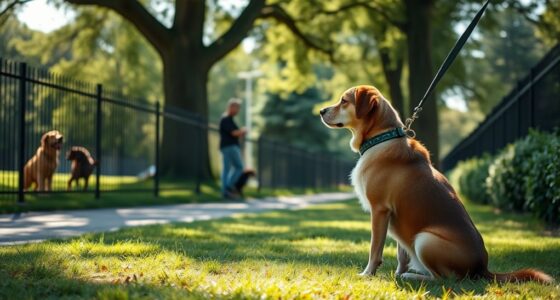To teach a reliable recall, start with simple commands like “come” in distraction-free environments, rewarding your dog immediately for obedience. Maintain consistency by using the same cue in different settings and gradually add distractions and distance as your dog improves. Use high-value rewards and positive reinforcement to build strong associations. Practice regularly and address challenges promptly. If you keep practicing these steps, you’ll discover how to guarantee your dog responds reliably even in busy, stimulating situations.
Key Takeaways
- Use consistent, simple recall commands and reinforce them with immediate, high-value rewards.
- Start training in distraction-free environments before gradually introducing distractions.
- Practice in various settings and at different distances to build reliability across situations.
- Make recall training fun and positive to encourage enthusiastic responses.
- Reinforce reliable responses through regular practice and avoid inconsistent cues or punishment.
Establishing a Strong Foundation With Basic Commands

Before you can teach your dog a reliable recall, you need to establish a strong foundation with basic commands. Start with simple training techniques like sit, stay, and come to build your dog’s understanding and trust. Consistent practice helps reinforce these commands and makes them reliable. Socialization strategies are equally important; exposing your dog to different environments, people, and other animals teaches them to remain calm and attentive. Use positive reinforcement, like treats and praise, to motivate your dog during training. Clear communication and patience are key. When your dog responds reliably to basic commands, they’ll be more receptive to recall training later. Establishing this solid base ensures your dog feels secure and enthusiastic to listen to you in any situation. Incorporating training consistency into your routine further strengthens your dog’s ability to recall reliably.
Choosing the Right Recall Cue and Consistency

Selecting the right recall cue is essential because it signals to your dog that it’s time to come back to you, so choose a word or phrase that’s simple, consistent, and unique. Consistency in your recall cue helps your dog understand that it applies regardless of environment or situation. Environmental cues can influence how your dog responds, so always use the same cue across different settings to reinforce its meaning. Additionally, training consistency is key to ensuring your dog reliably responds to the cue in any context. To stay organized, consider this table:
| Recall Cue | Environmental Cues | Consistency Tips |
|---|---|---|
| “Come” | Distractions nearby | Use the same word every time |
| “Here” | In noisy areas | Practice in various environments |
| “Let’s go” | During walks | Avoid changing cues |
Stick to one cue, practice regularly, and adapt your recall training to maintain a reliable recall. Regular training sessions help solidify the cue’s meaning and prevent clutter in your training routine, ensuring your dog responds reliably in all situations. Incorporating consistent training methods further enhances your dog’s understanding and response reliability.
Creating Positive Associations With the Recall Command

To create positive associations with the recall command, you need to make the experience enjoyable for your dog. Use high-value rewards, practice in distraction-free areas, and stay consistent with your commands. These steps help your dog link the recall cue with fun and success. Incorporating mindfulness practices can also reduce emotional triggers that may interfere with training. Focusing on quality training environments ensures your dog remains attentive and responsive during recall exercises.
Use High-Value Rewards
Using high-value rewards is vital for creating positive associations with the recall command. When your dog understands that responding reliably leads to exciting rewards, they’ll be motivated to obey consistently. During motivational training, choose rewards your dog loves—like favorite treats or playtime—and deliver them immediately after they come when called. Proper reward timing is crucial; the sooner the reward follows, the stronger the connection. To help you remember, here’s a quick overview:
| Reward Types | Examples |
|---|---|
| Food Rewards | Favorite treats, cheese |
| Play & Praise | Favorite toy, enthusiastic praise |
Focusing on high-value rewards helps reinforce the recall command, making your training more effective and enjoyable. Incorporating positive reinforcement techniques from the personal development field can further enhance your training success. Remember that consistency and patience are key components of successful dog training, and understanding the importance of reward-based learning can significantly improve your results. Additionally, understanding the science behind positive reinforcement can help you select the most effective rewards for your dog’s motivation.
Practice in Distraction-Free Areas
Practicing the recall command in distraction-free areas is essential for building a strong foundation. Start indoors where there are fewer stimuli, ensuring your dog can focus entirely on you. This promotes indoor safety, as your dog learns to respond reliably in a controlled environment. Once your dog consistently responds indoors, gradually introduce outdoor environments with minimal distractions. These settings help create positive associations with the recall command, reinforcing it as a safe and rewarding behavior. Keep training sessions short and upbeat, using high-value rewards to motivate your dog. Avoid overwhelming your dog with too many distractions too soon. By establishing a solid base in distraction-free areas, you set your dog up for success in more complex outdoor environments. Incorporating insights from AI Entertainment can also inspire innovative training techniques and tools to enhance your recall training. Additionally, understanding your dog’s breed traits can help tailor your training approach to better suit their natural tendencies and temperament. Consistent training routines further reinforce responsiveness and build your dog’s confidence, especially when considering individual dog personality differences.
Maintain Consistent Commands
Maintaining consistent commands helps your dog understand that the recall cue always means the same thing, which builds trust and clarity. To do this, use the same word or phrase every time you call your dog, avoiding variations that could confuse them. Incorporate recall training techniques like repeating the cue in different situations to reinforce understanding. Consistent commands also support behavior reinforcement strategies by creating positive associations when your dog responds correctly. When your dog reliably comes when called, reward immediately to strengthen the behavior. Avoid inconsistent signals or changing the command, as this can diminish reliability. By staying consistent, you help your dog learn faster and feel more confident, making future recall training smoother and more effective. Using a recall cue that is clear and simple is essential for effective training. Additionally, understanding the importance of payment security measures can further enhance your training environment by ensuring all transactions related to your dog’s training program are protected. Ensuring your training tools and resources are secure can also positively impact your consistency and confidence during training sessions. In addition, integrating positive reinforcement techniques can accelerate learning and make training sessions more enjoyable for your dog.
Practicing Recall in Controlled Environments

To build a reliable recall, start training your dog in controlled environments where distractions are minimal. Use clicker training to mark the exact moment your dog responds correctly, reinforcing positive behavior. Keep environmental cues consistent, like specific sounds or signals that signal it’s time to come. Practice in quiet spaces such as your backyard or inside your home, gradually introducing small distractions as your dog gets better. Focus on creating a calm, predictable setting that helps your dog associate the cues with returning to you. Short, frequent sessions work best, and always reward generously when your dog responds correctly. This solid foundation in a controlled environment prepares your dog for more challenging situations later. Understanding training environments can help you recognize and interpret your dog’s responses more accurately during training. Additionally, incorporating positive reinforcement techniques enhances motivation and encourages consistent recall behavior. A well-structured training environment supports effective learning and helps your dog develop trust in your commands.
Gradually Increasing Distractions and Distance

As your dog gets comfortable with basic recall, start adding more distractions and gradually increase the distance. This helps your dog stay focused and responsive in real-world situations. Keep training sessions consistent, and always reward your dog for returning promptly. Incorporating distraction training into your routines ensures your dog remains reliable even in challenging environments. Additionally, using versatile training environments like different outdoor settings can further enhance your dog’s adaptability and responsiveness. Remember that biodiversity benefits in natural settings can also serve as enriching environments for your dog during training, promoting mental stimulation and well-being.
Gradually Increasing Distractions and Distance
Starting to practice recall commands with increasing distractions and distance helps your dog learn to stay focused in real-life situations. This method strengthens your distraction management skills and enhances distance training. As you challenge your dog gradually, they learn to ignore tempting distractions and respond reliably from farther away. Remember, patience is key—progress at your dog’s pace. Use a clear, consistent cue and reward generously when they succeed.
| Level of Distraction | Distance from You | Success Rate |
|---|---|---|
| Low | Close | High |
| Moderate | Moderate | Improving |
| High | Far | Building trust |
| Very High | Maximum | Confidence |
Subheading Discussion Points
Building on your practice of managing distractions and distance, gradually increasing these challenges during recall training helps your dog learn to stay focused in real-world scenarios. Incorporate interactive games that require your dog to respond amid different stimuli, which enhances their recall reliability. Use socialization techniques to introduce your dog to new environments, people, and other animals, making distractions more natural and less intimidating. As you progress, add more distractions during training sessions, such as other dogs or noises, while maintaining control through positive reinforcement. These methods reinforce that your recall command is still valid, even in chaotic or stimulating situations. Consistently practicing with increasing difficulty ensures your dog develops a strong, dependable recall that holds up outside of structured training.
Using Rewards and Reinforcement Effectively

Using rewards and reinforcement effectively is key to encouraging your dog to reliably respond to the recall command. To do this, you need to employ motivational techniques that make coming to you more appealing than other activities. Reward timing is vital—immediately praise or treat your dog the moment they obey, reinforcing the connection between the command and a positive outcome. Consistent reinforcement helps build a strong habit, so always reward your dog for returning, even if they’re just exploring or distracted. Use a variety of rewards to keep your dog engaged, such as treats, toys, or praise. This approach boosts motivation, making your recall command more dependable over time. Remember, timely rewards are essential for effective reinforcement.
Troubleshooting Common Challenges and Maintaining Reliability

Even with consistent training, your dog may occasionally struggle to respond reliably to the recall command. To troubleshoot this, revisit socialization strategies to reinforce positive associations with coming when called, especially in distracting environments. Practice in different settings to build consistency and confidence. If your dog ignores the command, use emergency recall techniques, like a distinct whistle or a specific cue, to regain control quickly. Always keep your training sessions short and engaging to prevent boredom. Address challenges promptly and avoid punishing your dog for lapses, which can undermine reliability. Remember, patience and persistence are key. Reinforcing good recall behavior regularly helps maintain reliability, even when distractions arise, ensuring your dog responds promptly in all situations.
Frequently Asked Questions
How Long Does It Typically Take to Establish a Reliable Recall?
The duration timeline for establishing a reliable recall varies based on your dog’s age, temperament, and consistency. Typically, you can expect to see noticeable training milestones within a few weeks, but full reliability might take several months. You should focus on consistent practice, positive reinforcement, and gradually increasing distractions. Patience is key; with regular training, your dog will learn to come when called reliably over time.
Can Recall Training Be Effective for Older or Stubborn Dogs?
You can absolutely train older or stubborn dogs to recall, but it might take more patience due to age-related challenges like reduced attention span or hearing issues. To improve effectiveness, use motivation techniques such as treats or praise that appeal to your dog’s preferences. Consistent, positive reinforcement helps build trust and encourages your dog to respond reliably, regardless of age or stubbornness. Keep sessions short and fun to maintain their interest.
What Are Signs My Dog Is Not Responding Reliably?
Think of your dog’s response as a fragile glass that needs careful handling. If your dog ignores your cues, it signals recall inconsistency—like cracks appearing. You might notice hesitation, distracted glances, or quick distractions causing training setbacks. These signs show your dog isn’t reliably responding, and it’s time to reinforce commands with patience and positive reinforcement. Addressing these cues early helps rebuild trust and keeps your recall strong.
How Should I Handle Recall Failures During Training Sessions?
When your dog doesn’t come when called during training, stay calm and avoid punishment. Use positive reinforcement by rewarding immediate, enthusiastic responses with treats or praise. Keep training sessions consistent, practicing recall in various environments to build reliability. If your dog hesitates or ignores, gently re-engage with a high-value reward and repeat the command. Consistent, positive training helps your dog learn that coming when called is always worth their effort.
Are There Specific Breeds That Respond Better to Recall Training?
Some breeds are more responsive to recall training due to their natural tendencies and training adaptability. For example, Border Collies and Labrador Retrievers tend to pick up commands quickly because of their high breed responsiveness and enthusiasm to please. However, every dog is unique, so patience and consistent training are essential. Your approach should adapt to your dog’s individual personality, regardless of breed, to achieve reliable recall.
Conclusion
So, you’ve now got the secret recipe for a reliable recall—just add patience, consistency, and a sprinkle of treats. Remember, dogs aren’t mind-readers, so don’t expect perfection overnight. Keep practicing, stay positive, and resist the urge to give up when distractions strike. With time and effort, you’ll have a pup who comes running every time, no matter how tempting that squirrel or mailman may be. After all, who doesn’t want a perfect recall?










